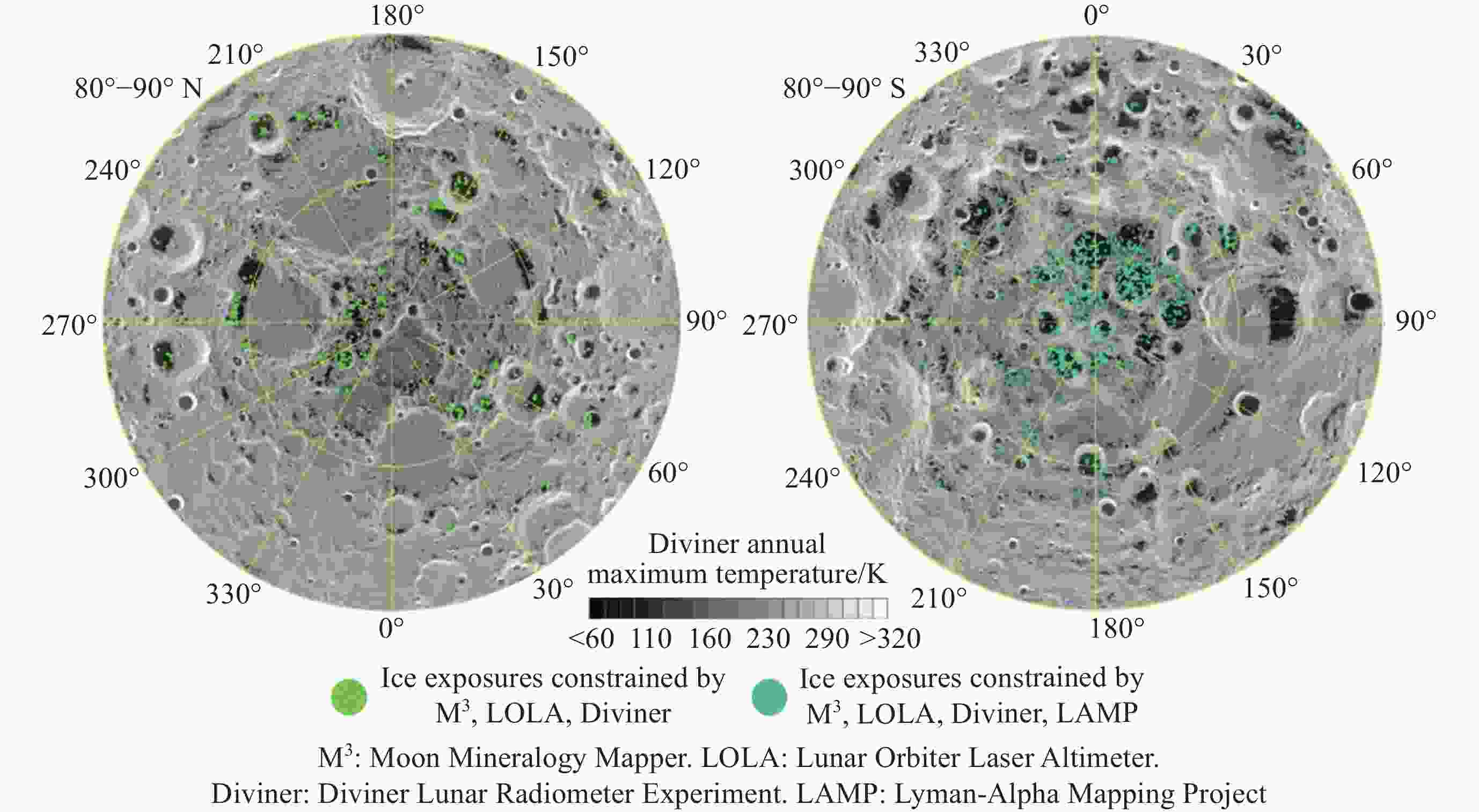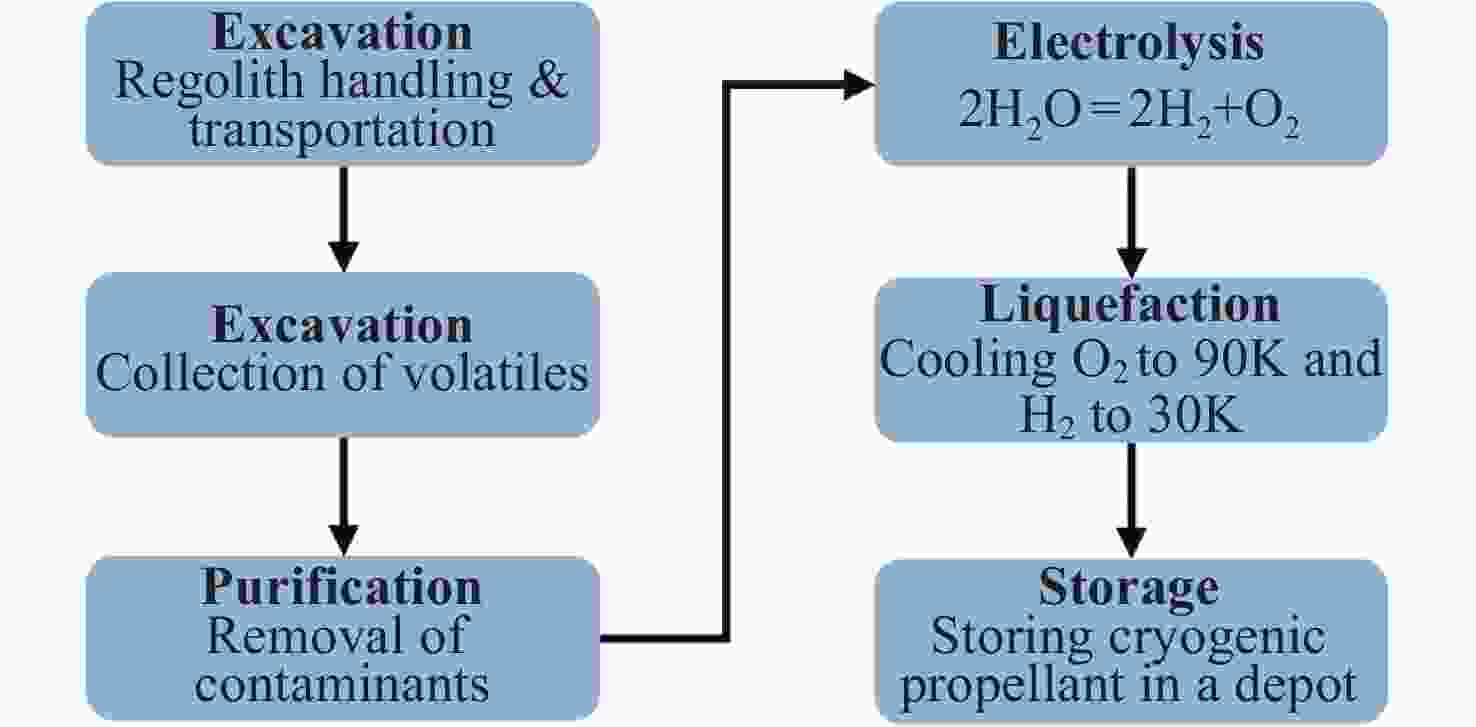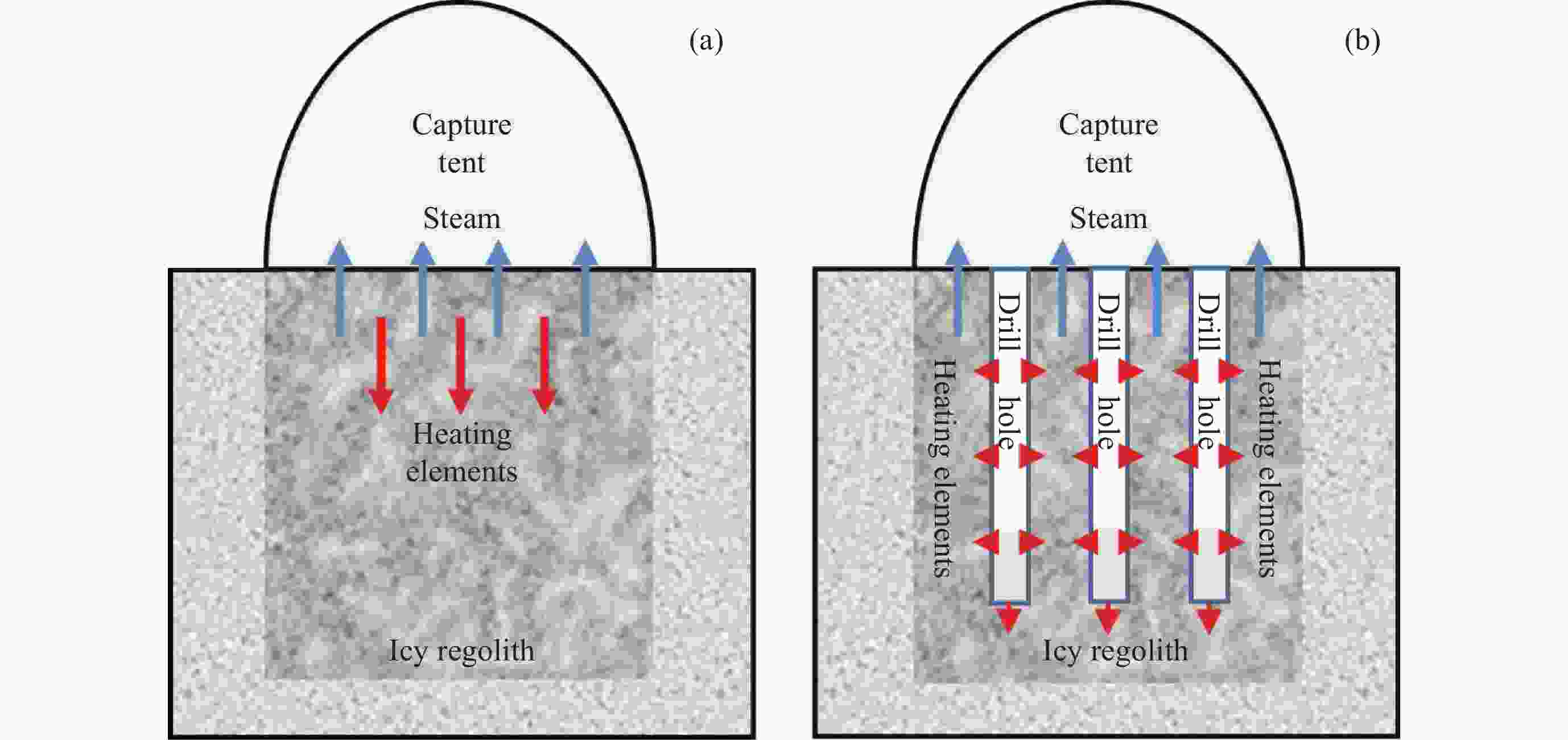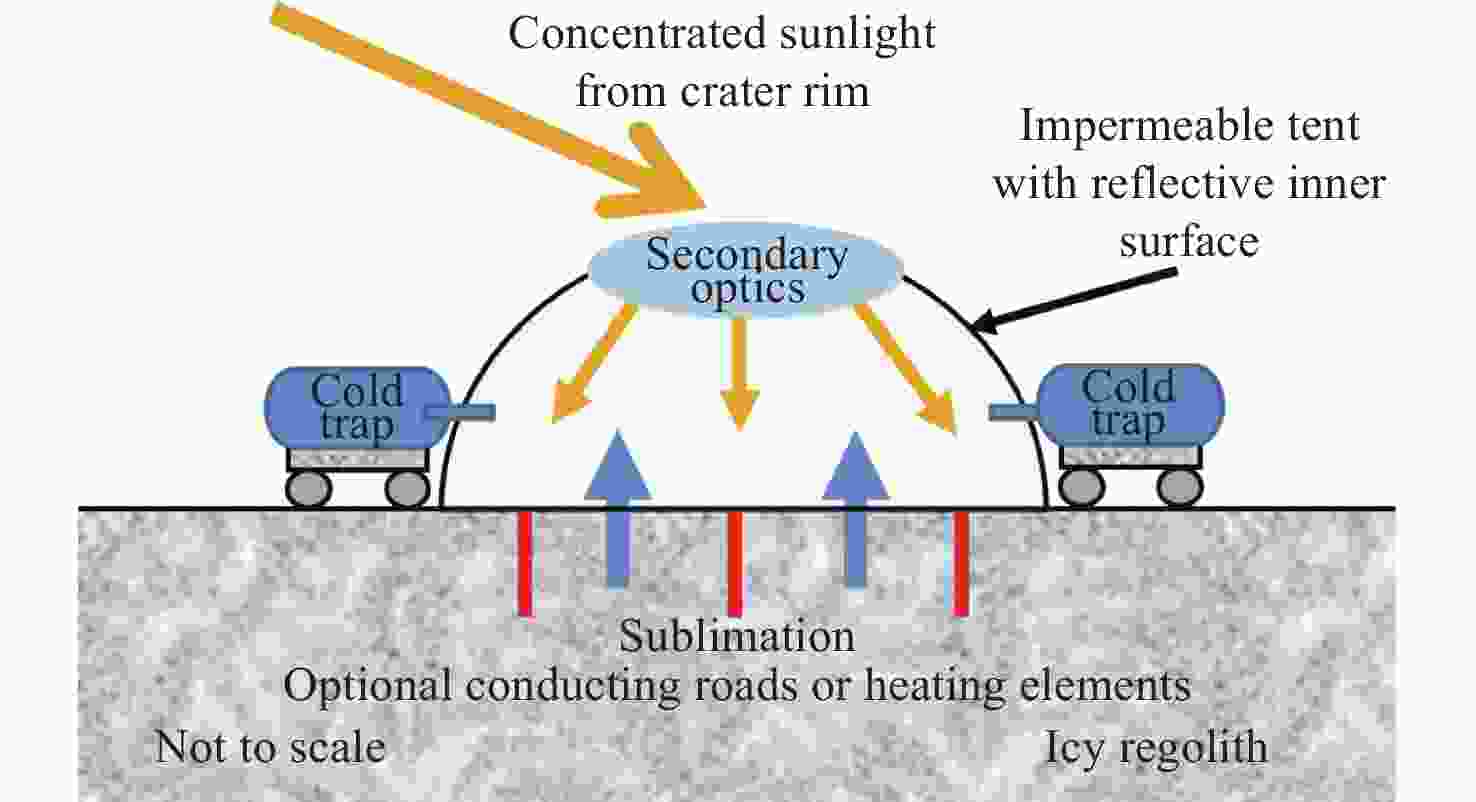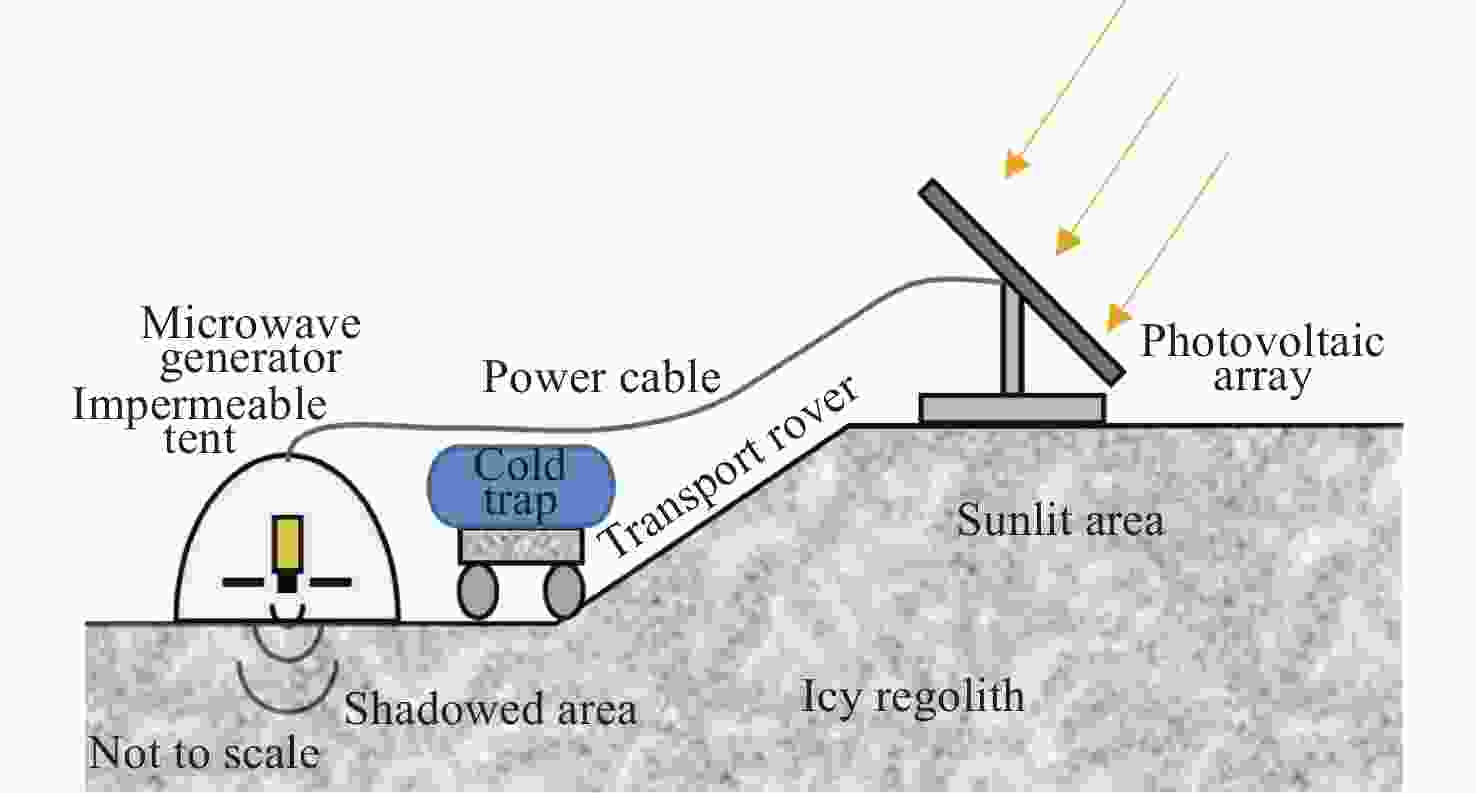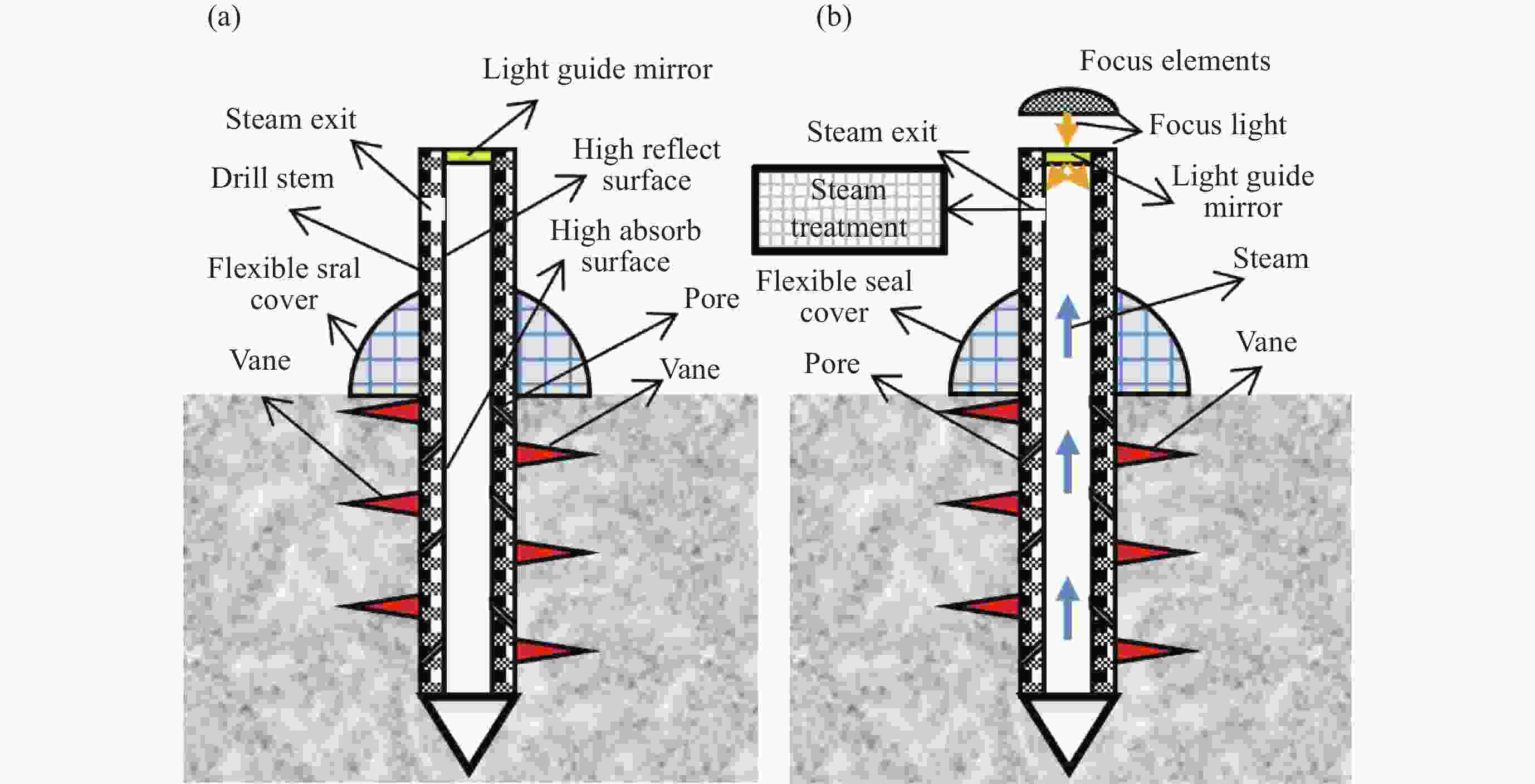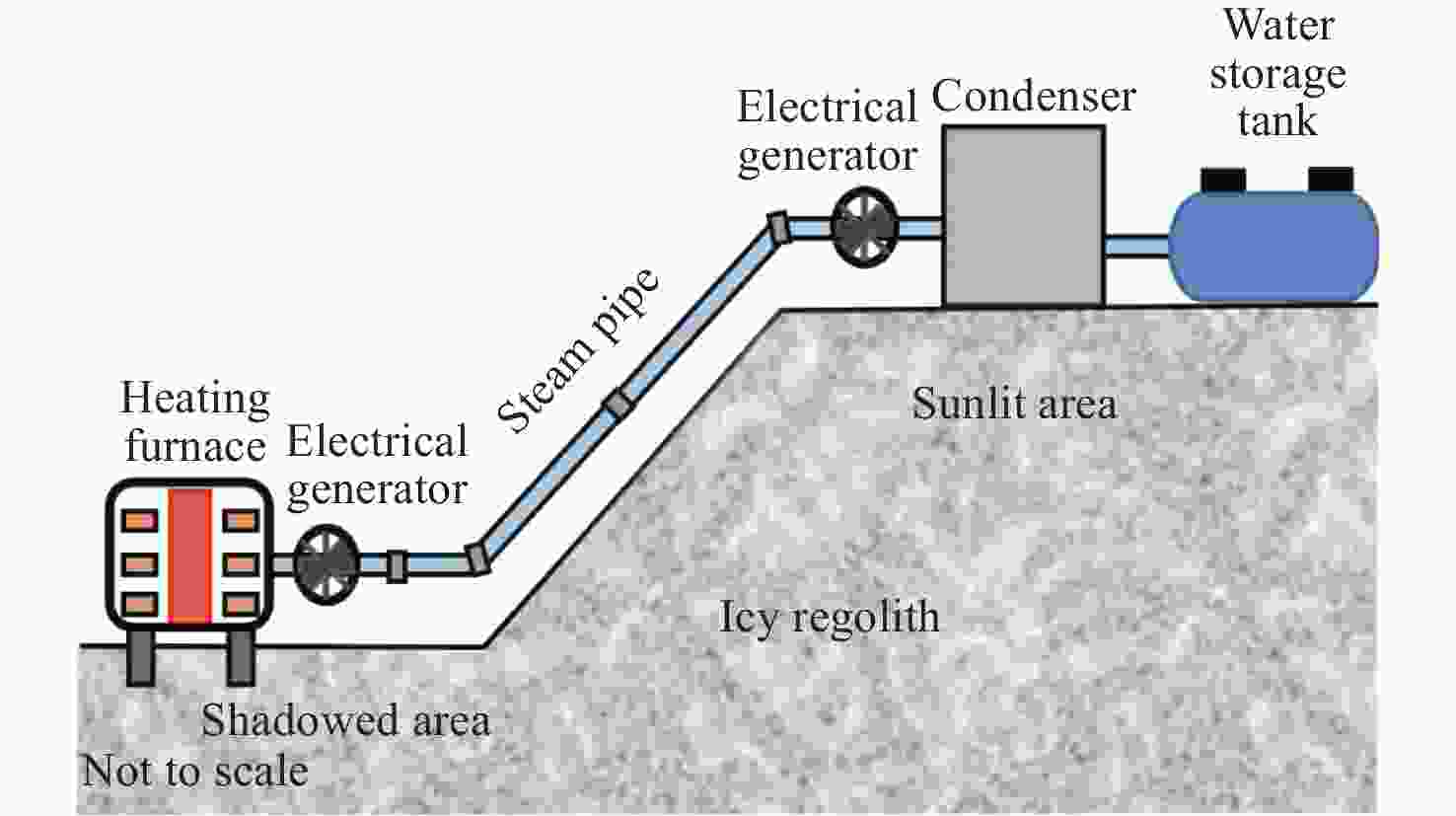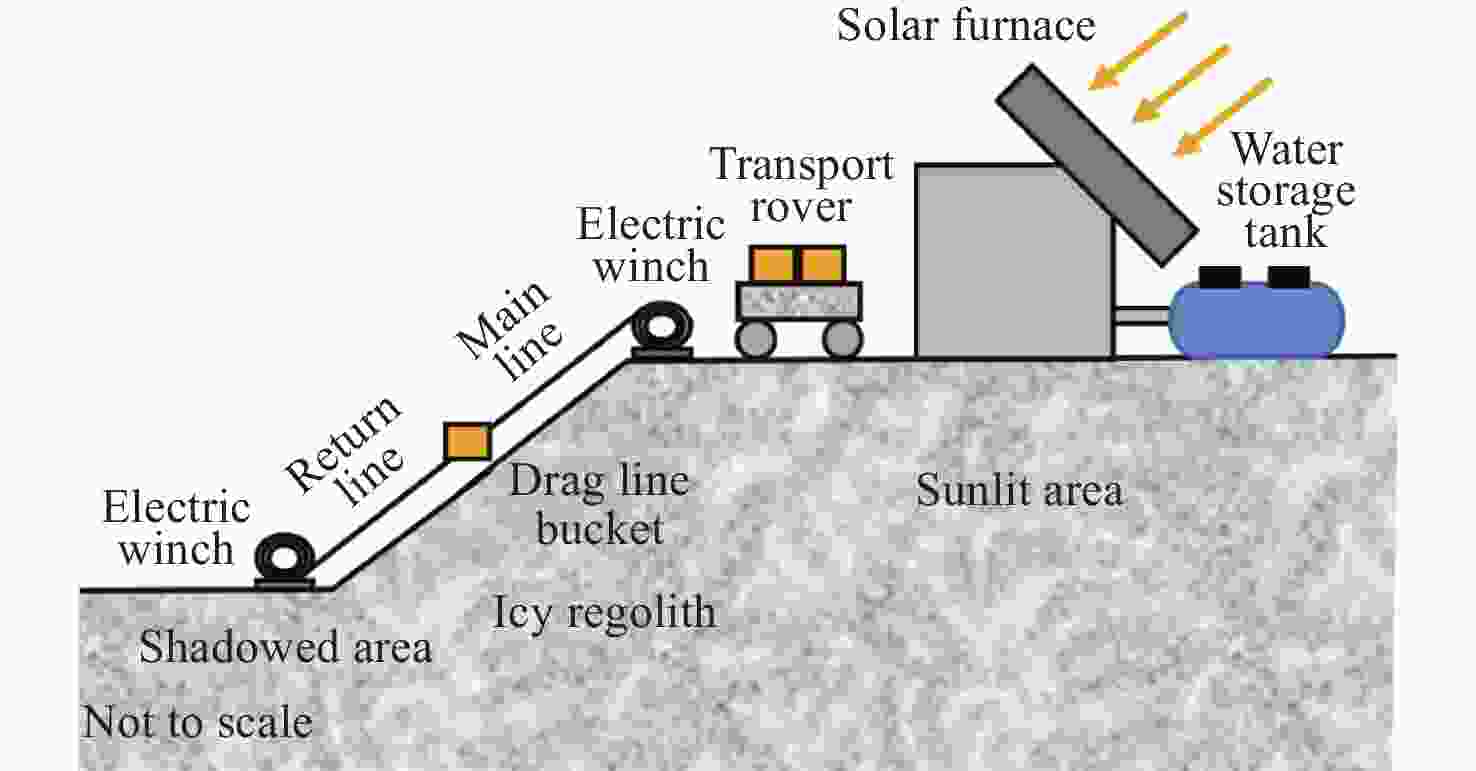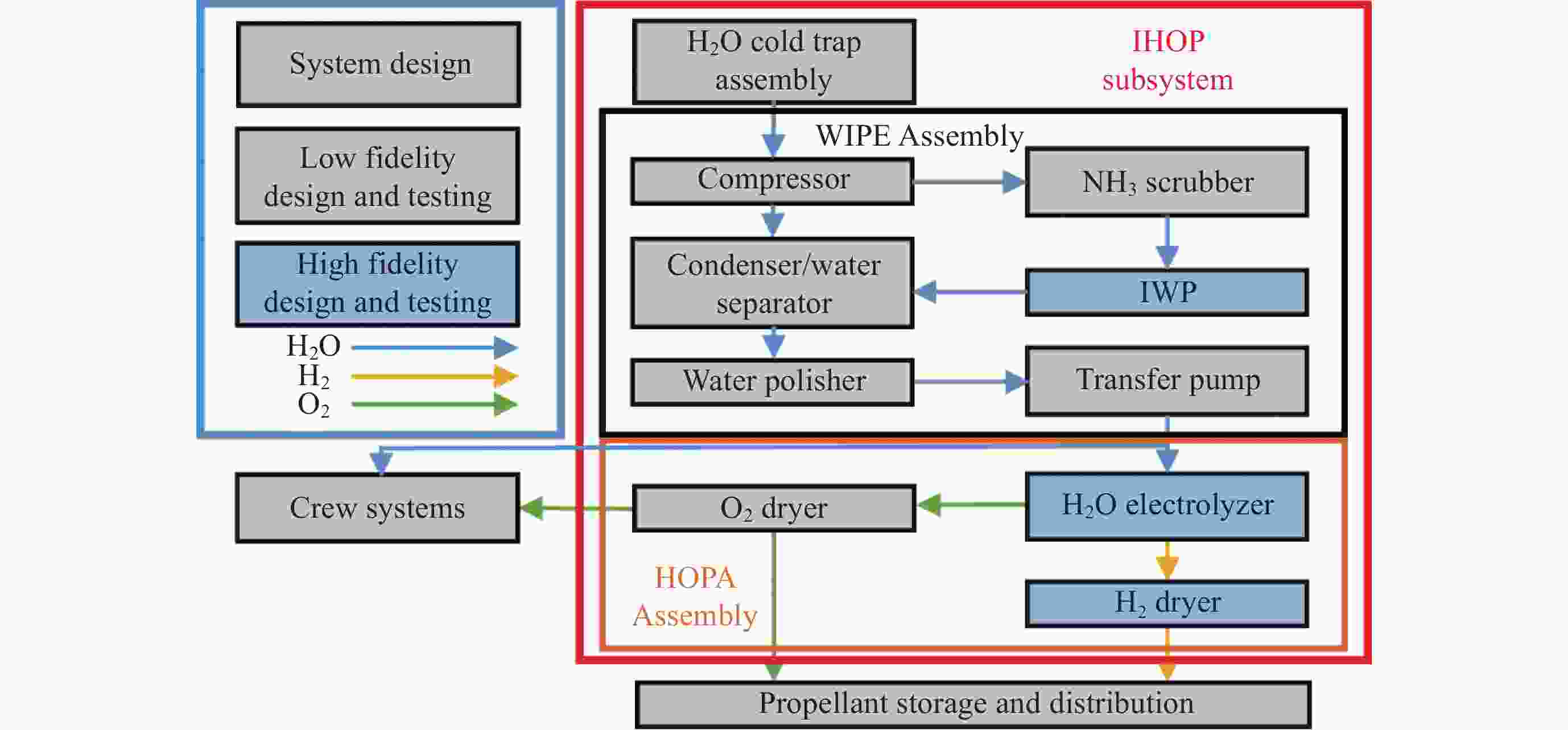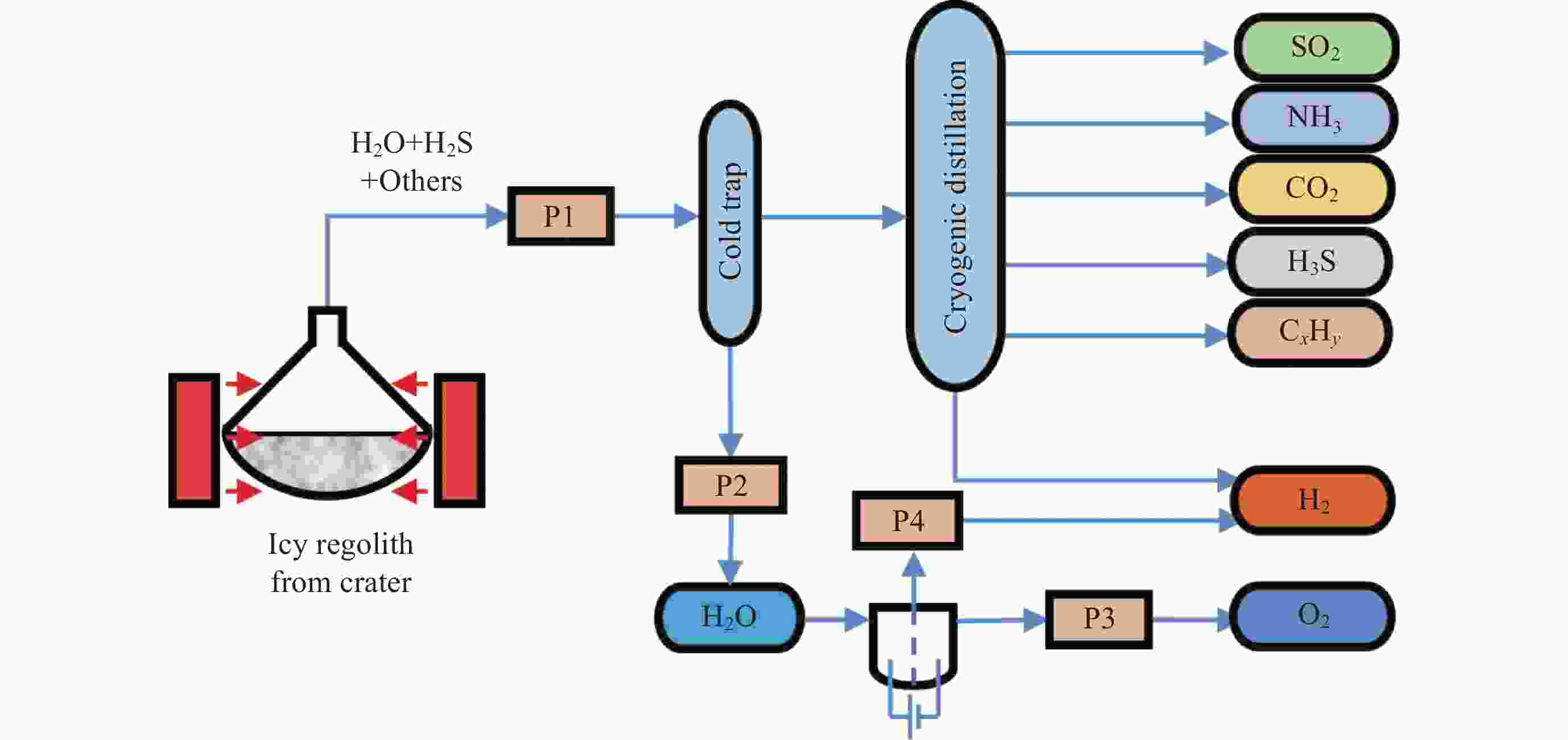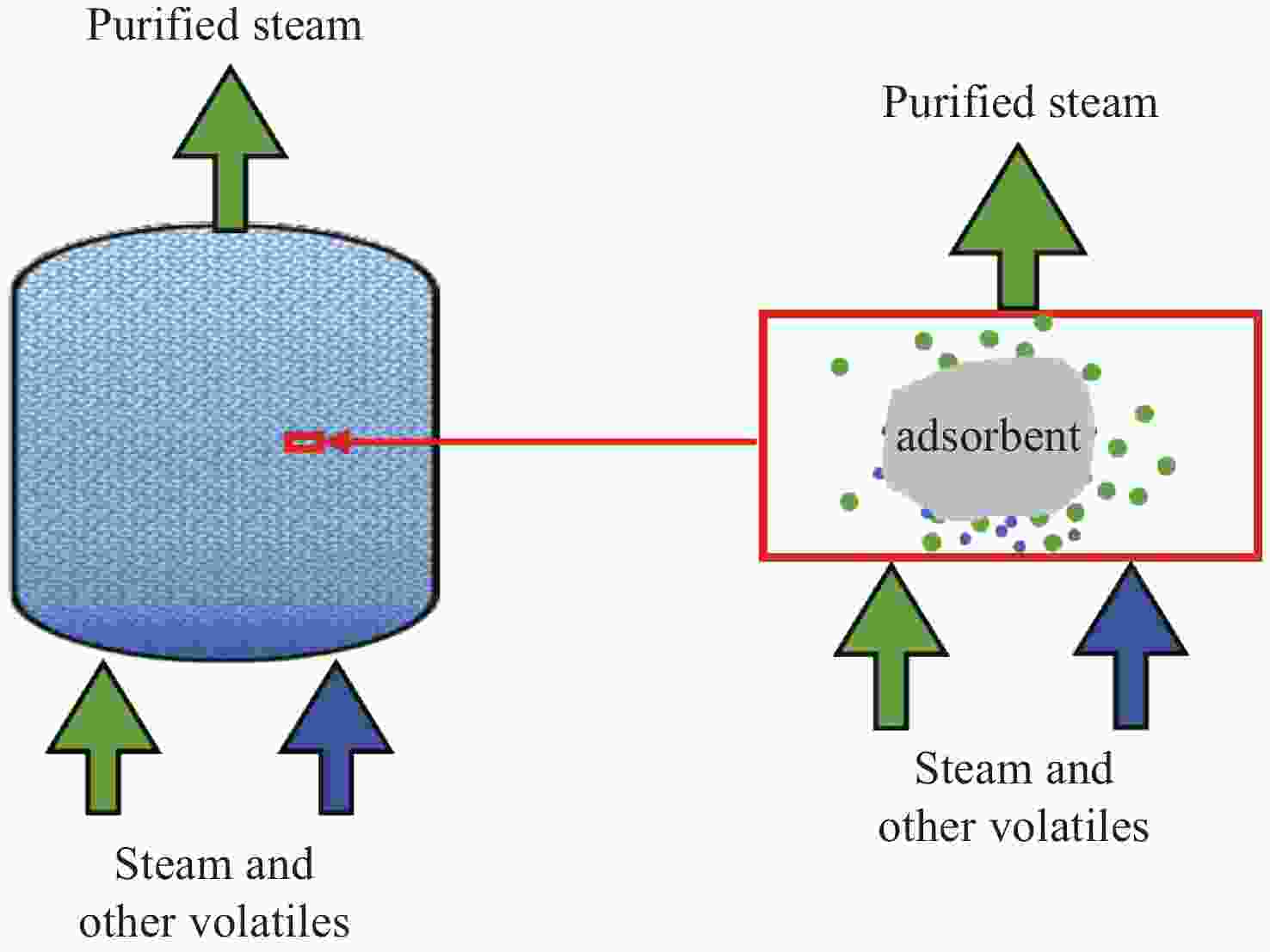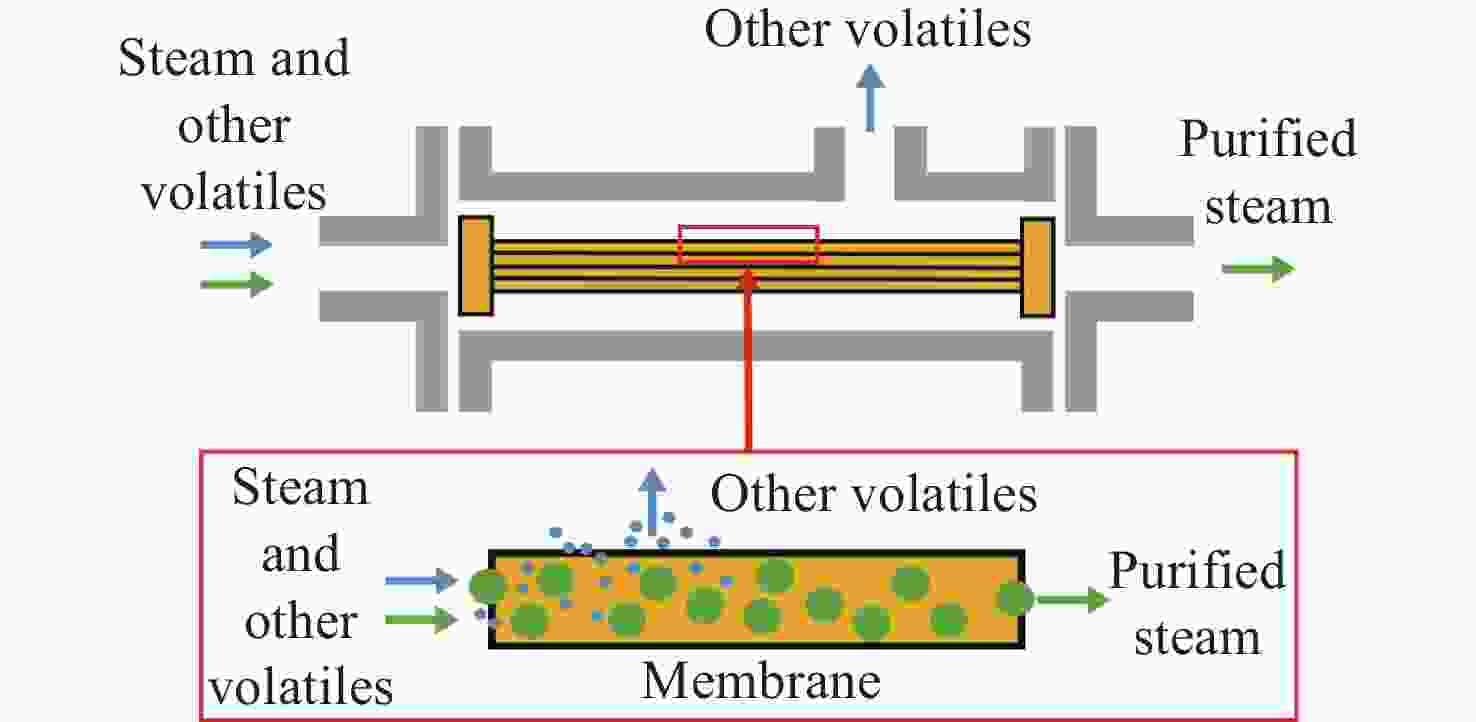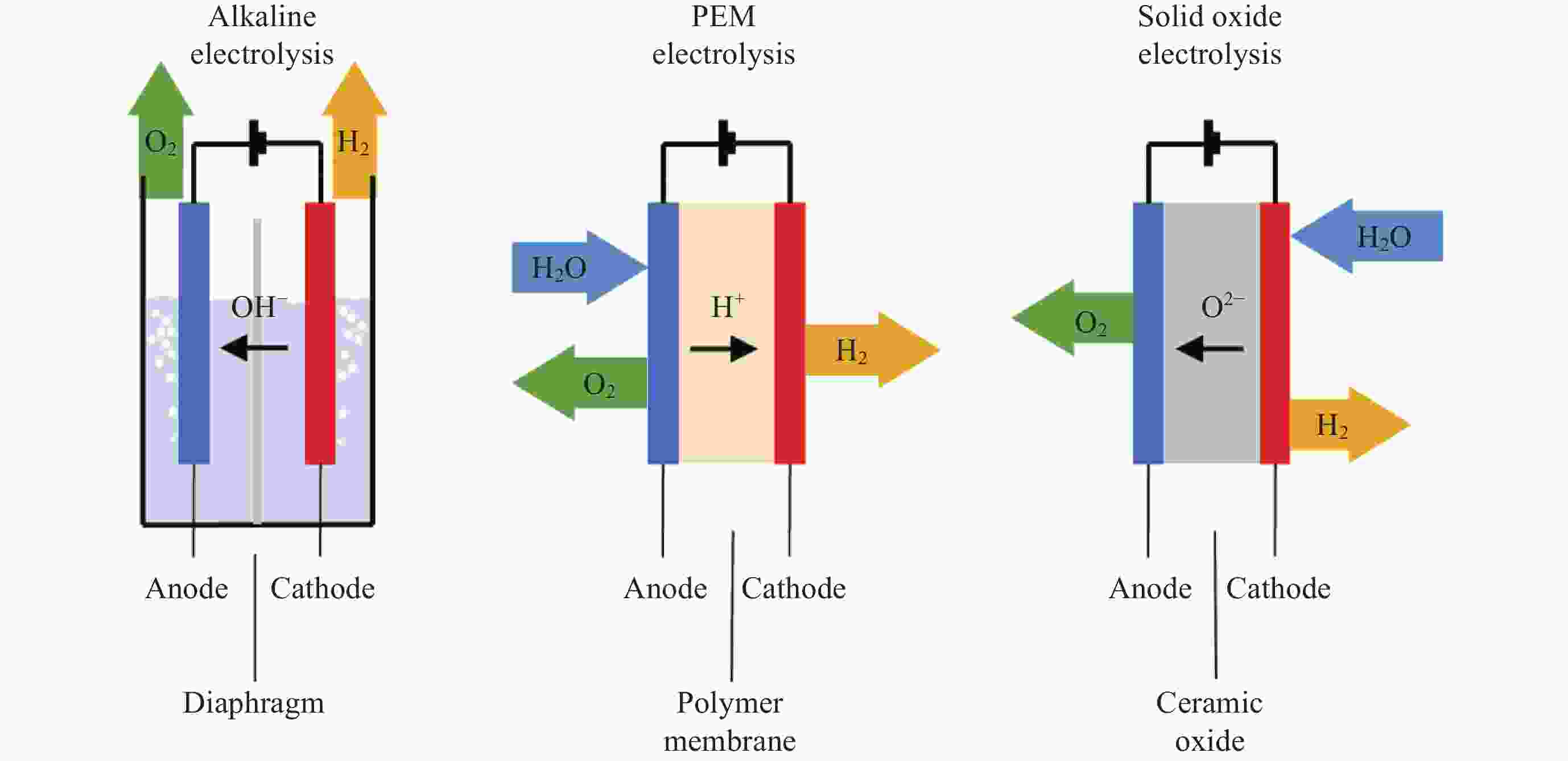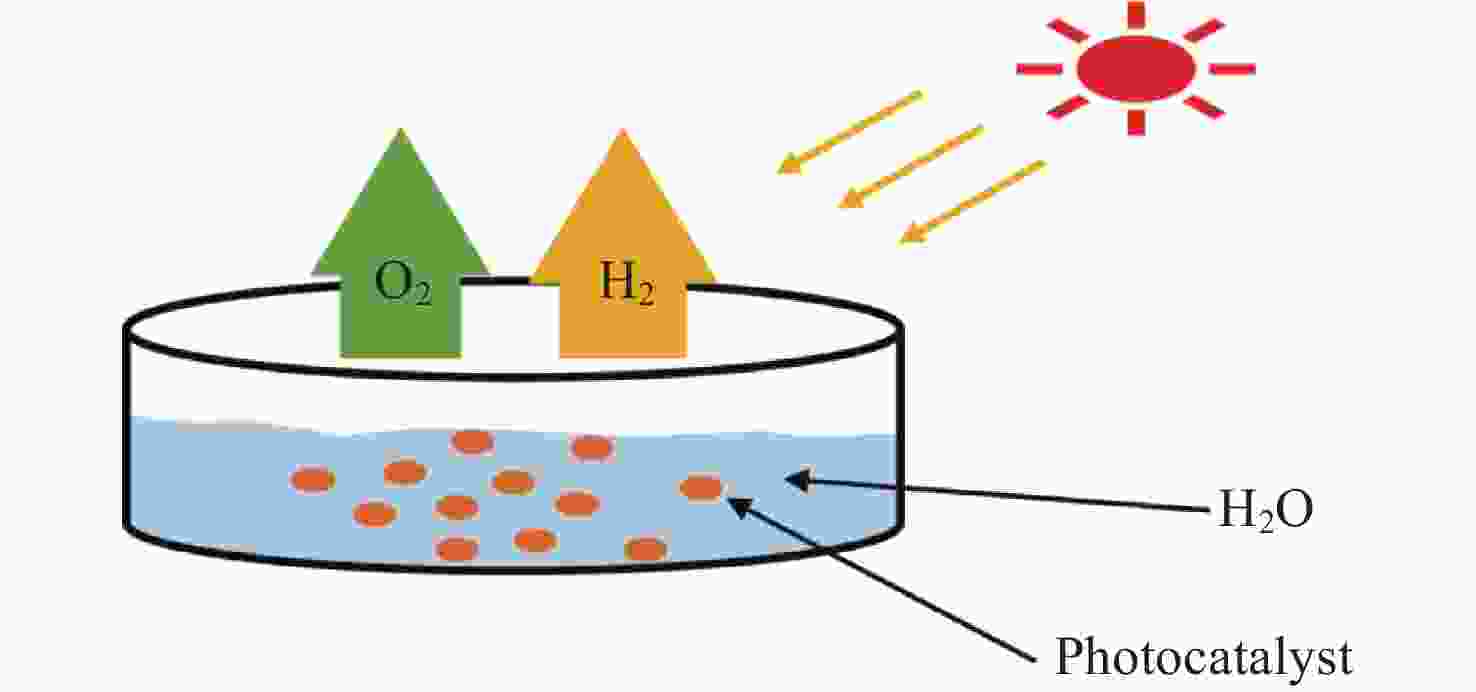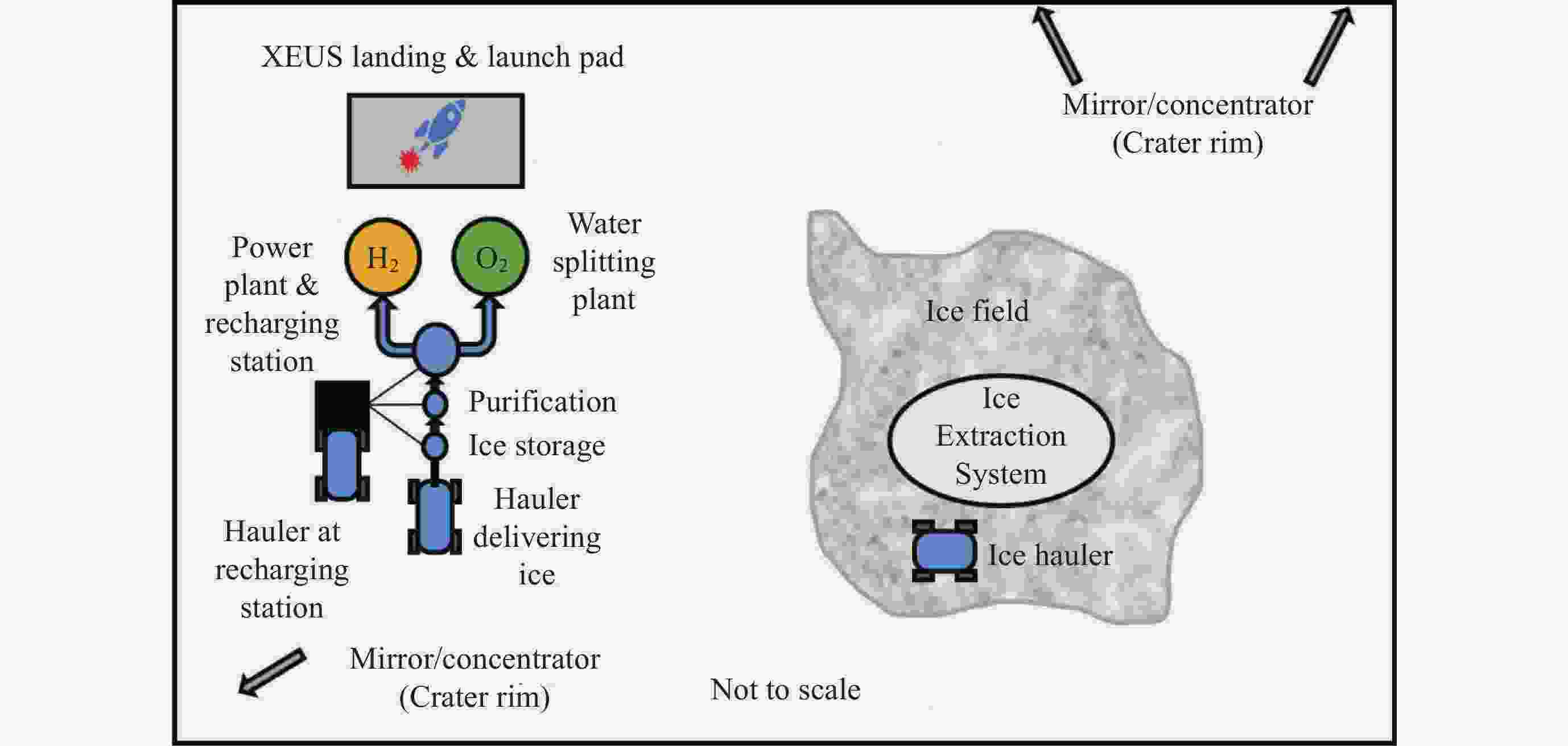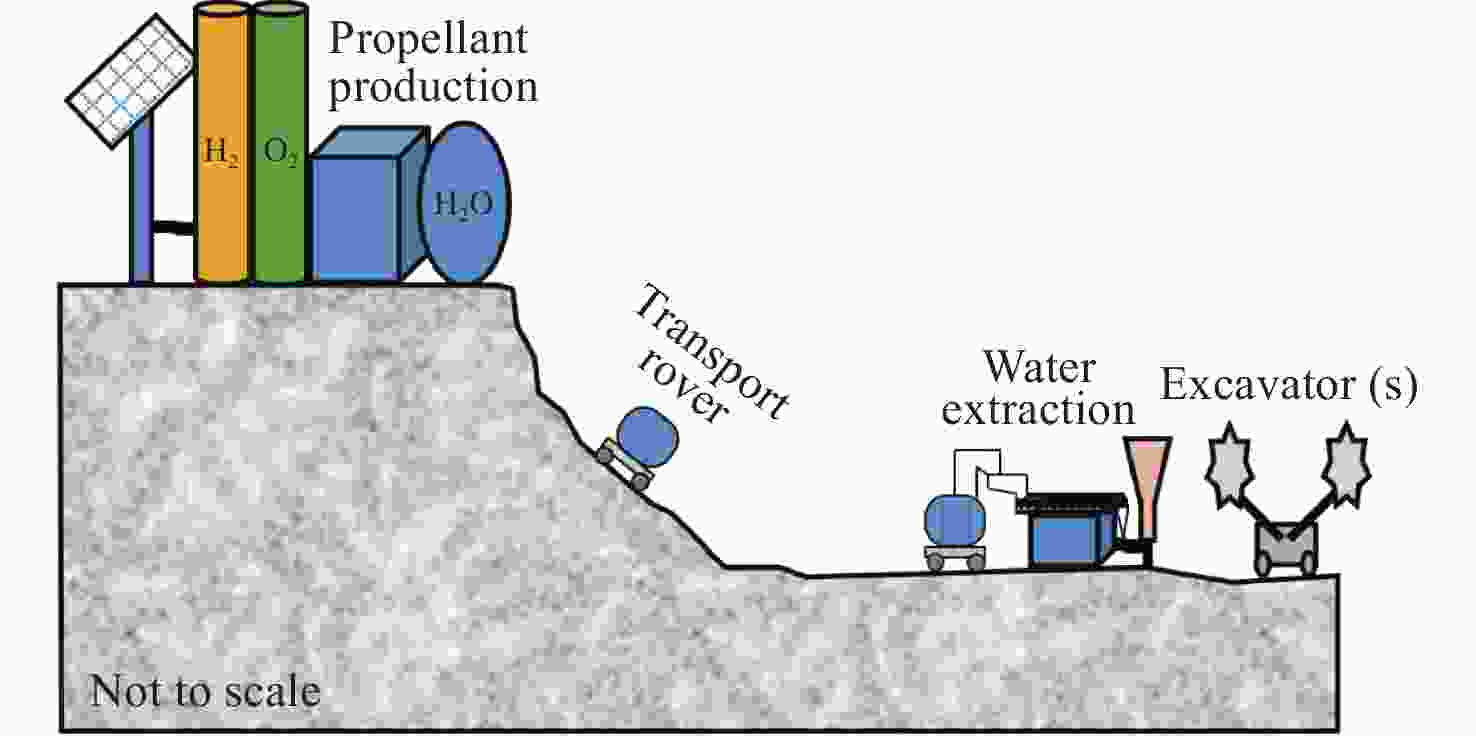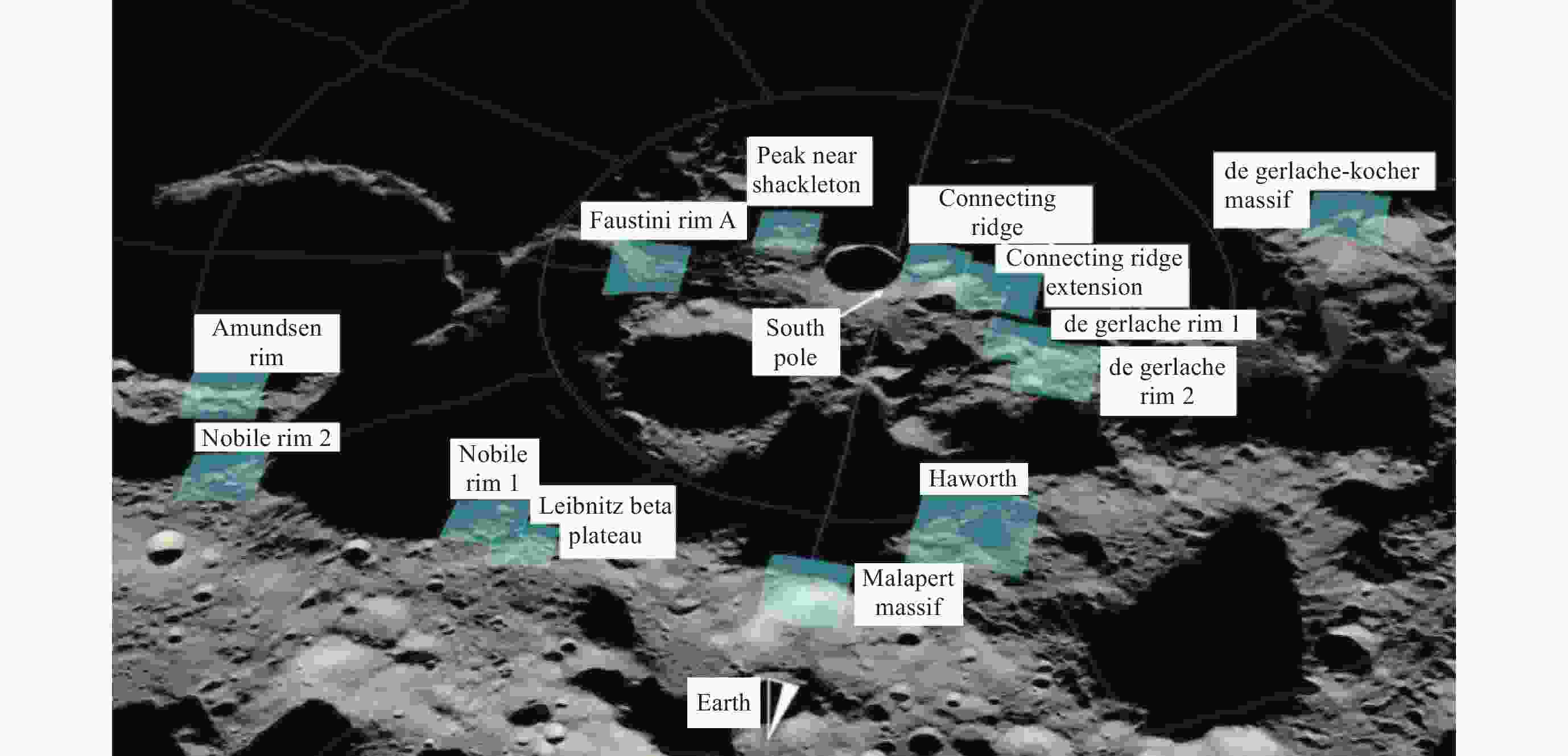Review of Comprehensive Exploitation Technology of Lunar Water Ice Resource
-
摘要: 水冰作为月球的重要资源,是未来月球科研站以及月球基地建设和运行的基本保障,开展月球水冰资源综合开发技术研究是目前各航天大国的关注热点之一。本文调研了有关月球水冰的探测和研究成果,阐述了月球水冰的赋存状态与分布特征,详细分析了月球水冰资源在开采提取、分离纯化、储存运输和分解利用等环节的技术方案,并简要评述了各个方案的优缺点。结合中国未来国际月球科研站的建设规划与美国以建立月球基地为目标的阿尔忒弥斯(Artemis)计划,评价分析了适宜开展月球水冰资源综合开发的地区和可行的技术方案,为中国在月球两极地区的水冰资源开发利用方案提供参考。Abstract: As an important resource on the moon, water ice is the basis for the construction and operation of the international lunar research station and lunar base in the future. The research on the comprehensive exploitation of the water ice resource in the lunar polar regions has also attracted the attention of the space powers in the world. The occurrence and distribution of lunar water ice are elaborately described based on a thorough survey of the exploration and research achievements of water ice in the lunar polar regions at home and abroad. The technical schemes of lunar water ice in excavation, extraction, separation and purification, transportation and storage, decomposition and utilization are introduced in detail, as well as the advantages and disadvantages of each scheme are briefly reviewed. The excavation and extraction steps can be classified into two categories based on the distinct extraction sites of lunar water ice: in-situ extraction and remote extraction. According to the different heating methods, the techniques of direct heating by sunlight, drilling heating, and microwave heating are introduced. In the separation and purification steps, three technologies are introduced: low-temperature distillation and cold trap, adsorption purification, and membrane purification technology. For the steps of transporting and storing, the water tanks are classified based on their position, and the requirements for materials are given. In the decomposition and utilization steps of the water ice resource, three kinds of electrode composition technology are introduced, including alkaline electrolysis, proton exchange membrane electrolysis, solid oxide electrolysis technology, and a photocatalytic decomposition technology using TiO2 as the catalyst is also presented. Combining the construction plans of the future international lunar research station in China and the Artemis program of the United States, which aims to establish a lunar base, the appropriate areas, and technical schemes for the comprehensive exploitation of the lunar water ice resource, is evaluated to provide important references for the exploitation and utilization of water ice in the lunar polar regions.
-
表 1 月球水冰开采提取方案对比
Table 1. Comparison of lunar water ice extraction schemes
方案参数 异地提取方案
(挖掘式)加热钻取技术
(钻孔式)加热开采技术
(光照直接加热式)质量/kg 40400 31900 29000 总功率/kW 2500 2500 2000 成本(Billion. dollars) 3.34 2.71 2.47 可用性/可维护性 中等 中–高 高 风险 低 中等 中等 表 2 不同组分在1 atm气压下的沸点
Table 2. Boiling points of different components at 1 atm pressure
组分 化学式 沸点 氦 He –268.9℃/4 K 氢气 H2 –252.9℃/20.3 K 氮气 N2 –195.8℃/77.4 K 一氧化碳 CO –191.5℃/81.6 K 氧气 O2 –183℃/90.2 K 甲烷 CH4 –161.5℃/111.7 K 乙烷 C2H4 –103.8℃/169.4 K 氯化氢 HCl –85℃/–188.2 K 硫化氢 H2S 59.6℃/213.6 K 氨气 NH3 –33.3℃/239.8 K 二氧化硫 SO2 –10℃/263.2 K 二氧化碳 CO2 >–56.6℃/>216.6 K* * 二氧化碳只有在压力大于5.2 bar 时才能保持液态。 表 3 不同膜的类型及纯化效率
Table 3. Different types of membranes and purification efficiency
膜类型 分离机制 纯化率/(%) 纳米多孔材料
(陶瓷、氧化物、有机聚合物)粒径差异 <95 无孔有机聚合物 溶解度与扩散速率差异 >95 致密金属 吸附/解离 >99.99 离子迁移(致密陶瓷) 离子导电性 >99.99 表 4 不同过程的储存技术
Table 4. Storage techniques of different processes
子系统 技术 描述和参考 运输水箱 特定尺寸
(铝质,50%空位)基于水容积估算 运输水箱移动平台 特定尺寸 基于载荷比1.5,所有电池和水箱
均为载荷进行估算电解水箱 特定尺寸 基于水容积估算 氢气和氧气储存 特定尺寸:薄壁铝(3 mm) 基于容积 表 5 提取月球水冰的关键基准参数
Table 5. Key reference parameters for extracting lunar water ice
项目 基准参数值 水冰含量/(wt%) 5 O2产量要求/t 10 O2/H2实际产量/t 13/1.7 所需水量/t 15 所需月壤的质量/t
(按75%的提取效率)398 30 cm下水冰的覆盖面积/m2 1024 水冰的运输时间/d 10 表 6 开展月球水冰资源综合开发技术研究的区域建议
Table 6. Proposal regions for conducting technical studies on comprehensive exploitation of lunar water ice
地点 特征 开采提取技术 技术条件与试验阶段 沙克尔顿撞击坑
(Shackleton crater)光照好、地势平缓
永久阴影区面积大
坑缘有永久光照区
预估水冰丰富异地提取 月球科研站/基地早期 霍沃思撞击坑
(Haworth crater)光照好
撞击坑深
百万吨水冰储量就地加热开采
或加热钻取月球科研站/基地早期 舒梅克撞击坑
(Shoemaker crater)撞击坑较深
地形相对复杂
水冰储量大就地加热开采
或加热钻取技术条件相对成熟 坎布斯撞击坑
(Cabeus crater)直径大
地形复杂
千万吨水冰储量就地加热开采
或加热钻取技术条件相对成熟 福斯蒂尼撞击坑
(Faustini crater)地形复杂
百万吨水冰储量就地加热开采
或加热钻取技术条件相对成熟 表 7 可行性较高的水冰资源综合开发技术总结
Table 7. Summary of the feasible technology for comprehensive exploitation of lunar water ice
阶段 可行性较高的技术 备注 水冰开采提取 就地提取技术 加热开采或钻取 水的分离提纯 冷阱低温蒸馏和吸附纯化技术 选择合适的吸附剂 水的分解 电解技术 确保水足够纯净 水的储存运输 按需定制 满足各工作环节要求 -
[1] KUIPER G P. The Atmospheres of the Earth and Planets[M]. Chicago: University of Chicago Press, 1952 [2] LUCEY P, KOROTEV R L, GILLS J J, et al. Understanding the lunar surface and space-Moon interactions[J]. Reviews in Mineralogy and Geochemistry, 2006, 60(1): 83-219 doi: 10.2138/rmg.2006.60.2 [3] ÖPIK E J, SINGER S F. Escape of gases from the moon[J]. Journal of Geophysical Research, 1960, 65(10): 3065-3070 doi: 10.1029/JZ065i010p03065 [4] WATSON K, MURRAY B, BROWN H. On the possible presence of ice on the Moon[J]. Journal of Geophysical Research, 1961, 66(5): 1598-1600 doi: 10.1029/JZ066i005p01598 [5] WATSON K, MURRAY B C, BROWN H. The behavior of volatiles on the lunar surface[J]. Journal of Geophysical Research, 1961, 66(9): 3033-3045 doi: 10.1029/JZ066i009p03033 [6] NOZETTE S, LICHTENBERG C L, SPUDIS P, et al. The Clementine bistatic radar experiment[J]. Science, 1996, 274(5292): 1495-1498 doi: 10.1126/science.274.5292.1495 [7] STACY N J S, CAMPBELL D B, FORD P G. Arecibo radar mapping of the lunar poles: a search for ice deposits[J]. Science, 1997, 276(5318): 1527-1530 doi: 10.1126/science.276.5318.1527 [8] WEIDENSCHILLING S J. The possibility of ice on the Moon[J]. Science, 1997, 278(5335): 144-145 doi: 10.1126/science.278.5335.144 [9] FELDMAN W C, MAURICE S, BINDER A B, et al. Fluxes of fast and epithermal neutrons from Lunar Prospector: evidence for water ice at the lunar poles[J]. Science, 1998, 281(5382): 1496-1500 doi: 10.1126/science.281.5382.1496 [10] FELDMAN W C, LAWRENCE D J, ELPHIC R C, et al. Polar hydrogen deposits on the Moon[J]. Journal of Geophysical Research: Planets, 2000, 105(E2): 4175-4195 doi: 10.1029/1999JE001129 [11] GOLDSTEIN D B, NEREM R S, BARKER E S, et al. Impacting Lunar Prospector in a cold trap to detect water ice[J]. Geophysical Research Letters, 1999, 26(12): 1653-1656 doi: 10.1029/1999GL900384 [12] CLARK R N. Detection of adsorbed water and hydroxyl on the Moon[J]. Science, 2009, 326(5952): 562-564 doi: 10.1126/science.1178105 [13] PIETERS C M, GOSWAMI J N, CLARK R N, et al. Character and spatial distribution of OH/H2O on the surface of the Moon seen by M3 on Chandrayaan-1[J]. Science, 2009, 326(5952): 568-572 doi: 10.1126/science.1178658 [14] 曾献棣, 唐红, 李雄耀, 等. 月表太阳风成因水的研究现状和意义[J]. 地球科学进展, 2018, 33(5): 473-482 doi: 10.11867/j.issn.1001-8166.2018.05.0473ZENG Xiandi, TANG Hong, LI Xiongyao, et al. Research review and significance of lunar water originated from solar wind[J]. Advances in Earth Science, 2018, 33(5): 473-482 doi: 10.11867/j.issn.1001-8166.2018.05.0473 [15] SPUDIS P D, BUSSEY D B J, BALOGA S M, et al. Initial results for the north pole of the Moon from Mini‐SAR, Chandrayaan‐1 mission[J]. Geophysical Research Letters, 2010, 37(6): L06204 [16] MITROFANOV I G, SANIN A B, BOYNTON W V, et al. Hydrogen mapping of the lunar south pole using the LRO neutron detector experiment LEND[J]. Science, 2010, 330(6003): 483-486 doi: 10.1126/science.1185696 [17] COLAPRETE A, SCHULTZ P, HELDMANN J, et al. Detection of water in the LCROSS ejecta plume[J]. Science, 2010, 330(6003): 463-468 doi: 10.1126/science.1186986 [18] LI S, LUCEY P G, MILLIKEN R E, et al. Direct evidence of surface exposed water ice in the lunar polar regions[J]. Proceedings of the National Academy of Sciences of the United States of America, 2018, 115(36): 8907-8912 doi: 10.1073/pnas.1802345115 [19] ARNOLD J R. Ice in the lunar polar regions[J]. Journal of Geophysical Research: Solid Earth, 1979, 84(B10): 5659-5668 doi: 10.1029/JB084iB10p05659 [20] 吴伟仁, 刘继忠, 唐玉华, 等. 中国探月工程[J]. 深空探测学报, 2019, 6(5): 405-416 doi: 10.15982/j.issn.2095-7777.2019.05.001WU Weiren, LIU Jizhong, TANG Yuhua, et al. China lunar exploration program[J]. Journal of Deep Space Exploration, 2019, 6(5): 405-416 doi: 10.15982/j.issn.2095-7777.2019.05.001 [21] 裴照宇, 刘继忠, 王倩, 等. 月球探测进展与国际月球科研站[J]. 科学通报, 2020, 65(24): 2577-2586 doi: 10.1360/TB-2020-0582PEI Zhaoyu, LIU Jizhong, WANG Qian, et al. Overview of lunar exploration and International Lunar Research Station[J]. Chinese Science Bulletin, 2020, 65(24): 2577-2586 doi: 10.1360/TB-2020-0582 [22] 李默. 月球南极探测任务着陆区选址研究[D]. 北京: 中国地质大学(北京), 2021LI Mo. Research on Site Selection of Landing Area for lunar South Pole Exploration Mission[D]. Beijing: China University of Geosciences (Beijing), 2021 [23] 王赤, 杨帆, 韩淋, 等. 2021年空间科学热点回眸[J]. 科技导报, 2022, 40(5): 6-21WANG Chi, YANG Fan, HAN Lin, et al. NASA’s probe first enters solar atmosphere—a review of hot topics of space science in 2021[J]. Science & Technology Review, 2022, 40(5): 6-21 [24] SMITH M, CRAIG D, HERRMANN N, et al. The Artemis program: an overview of NASA's activities to return humans to the moon[C]//Proceedings of the 2020 IEEE Aerospace Conference. Big Sky: IEEE, 2020: 1-10 [25] 何成旦, 李亚胜, 温智, 等. 月表水冰探测与赋存形态研究进展[J]. 真空与低温, 2021, 27(6): 589-600 doi: 10.3969/j.issn.1006-7086.2021.06.011HE Chengdan, LI Yasheng, WEN Zhi, et al. Research progress of lunar surface water ice detection and occurrence form[J]. Vacuum and Cryogenics, 2021, 27(6): 589-600 doi: 10.3969/j.issn.1006-7086.2021.06.011 [26] 李雄耀, 魏广飞, 曾小家, 等. 极区月壤和水冰形成演化机制及物理特性研究[J]. 深空探测学报, 2022, 9(2): 123-133 doi: 10.15982/j.issn.2096-9287.2022.20210147LI Xiongyao, WEI Guangfei, ZENG Xiaojia, et al. Review of the lunar regolith and water ice on the poles of the Moon[J]. Journal of Deep Space Exploration, 2022, 9(2): 123-133 doi: 10.15982/j.issn.2096-9287.2022.20210147 [27] JONES B M, ALEKSANDROV A, HIBBITTS K, et al. Solar wind-induced water cycle on the Moon[J]. Geophysical Research Letters, 2018, 45(20): 10959-10967 [28] STEWART B D, PIERAZZO E, GOLDSTEIN D B, et al. Simulations of a comet impact on the Moon and associated ice deposition in polar cold traps[J]. Icarus, 2011, 215(1): 1-16 doi: 10.1016/j.icarus.2011.03.014 [29] PREM P, ARTEMIEVA N A, GOLDSTEIN D B, et al. Transport of water in a transient impact-generated lunar atmosphere[J]. Icarus, 2015, 255: 148-158 doi: 10.1016/j.icarus.2014.10.017 [30] CANNON K M, BRITT D T. A geologic model for lunar ice deposits at mining scales[J]. Icarus, 2020, 347: 113778 doi: 10.1016/j.icarus.2020.113778 [31] CANNON K M, DEUTSCH A N, HEAD J W, et al. Stratigraphy of ice and ejecta deposits at the lunar poles[J]. Geophysical Research Letters, 2020, 47(21): e2020GL088920 [32] CANNON K M, DEUTSCH A N, HEAD J W. Stratigraphy of ice and ejecta deposits at the lunar poles: updates and new insights[C]//Proceedings of the 52 nd Lunar and Planetary Science Conference. 2021, 2548: 2497 [33] SPUDIS P D, BUSSEY D B J, BALOGA S M, et al. Evidence for water ice on the Moon: results for anomalous polar craters from the LRO Mini-RF imaging radar[J]. Journal of Geophysical Research: Planets, 2013, 118(10): 2016-2029 doi: 10.1002/jgre.20156 [34] THOMSON B J, BUSSEY D B J, NEISH C D, et al. An upper limit for ice in Shackleton crater as revealed by LRO Mini-RF orbital radar[J]. Geophysical Research Letters, 2012, 39(14): L14201 [35] CAMPBELL D B, CAMPBELL B A, CARTER L M, et al. No evidence for thick deposits of ice at the lunar south pole[J]. Nature, 2006, 443(7113): 835-837 doi: 10.1038/nature05167 [36] NEISH C D, BUSSEY D B J, SPUDIS P, et al. The nature of lunar volatiles as revealed by Mini-RF observations of the LCROSS impact site[J]. Journal of Geophysical Research: Planets, 2011, 116(E1): E01005 [37] FA W Z, CAI Y Z. Circular polarization ratio characteristics of impact craters from Mini-RF observations and implications for ice detection at the polar regions of the Moon[J]. Journal of Geophysical Research: Planets, 2013, 118(8): 1582-1608 doi: 10.1002/jgre.20110 [38] FELDMAN W C, MAURICE S, LAWRENCE D J, et al. Evidence for water ice near the lunar poles[J]. Journal of Geophysical Research: Planets, 2001, 106(E10): 23231-23251 doi: 10.1029/2000JE001444 [39] CANNON K M, BRITT D T. Accessibility data set for large permanent cold traps at the lunar poles[J]. Earth and Space Science, 2020, 7(10): e2020EA001291 [40] LAWRENCE D J. A tale of two poles: toward understanding the presence, distribution, and origin of volatiles at the polar regions of the Moon and Mercury[J]. Journal of Geophysical Research: Planets, 2017, 122(1): 21-52 doi: 10.1002/2016JE005167 [41] LI S, MILLIKEN R E. Water on the surface of the Moon as seen by the Moon Mineralogy Mapper: distribution, abundance, and origins[J]. Science Advances, 2017, 3(9): e1701471 doi: 10.1126/sciadv.1701471 [42] BUSSEY D B J, SPUDIS P D, ROBINSON M S. Illumination conditions at the lunar South Pole[J]. Geophysical Research Letters, 1999, 26(9): 1187-1190 doi: 10.1029/1999GL900213 [43] BUSSEY D B J, LUCEY P G, STEUTEL D, et al. Permanent shadow in simple craters near the lunar poles[J]. Geophysical Research Letters, 2003, 30(6): 1278 [44] LUCHSINGER K M, CHANOVER N J. Seasons of ice: water ice migration and seasonal transient shadow at the lunar poles[J]. Journal of Geophysical Research: Planets, 2022, 127(10): e2022JE007336 [45] RUBANENKO L, VENKATRAMAN J, PAIGE D A. Thick ice deposits in shallow simple craters on the Moon and Mercury[J]. Nature Geoscience, 2019, 12(8): 597-601 doi: 10.1038/s41561-019-0405-8 [46] BROWN H M, BOYD A K, DENEVI B W, et al. Resource potential of lunar permanently shadowed regions[J]. Icarus, 2022, 377: 114874 doi: 10.1016/j.icarus.2021.114874 [47] AUSTIN A, SHERWOOD B, ELLIOTT J, et al. Robotic lunar surface operations 2[J]. Acta Astronautica, 2020, 176: 424-437 doi: 10.1016/j.actaastro.2020.06.038 [48] SOWERS G F, DREYER C B. Ice mining in lunar permanently shadowed regions[J]. New Space, 2019, 7(4): 235-244 doi: 10.1089/space.2019.0002 [49] BRISSET J, MILETICH T, METZGER P. Thermal extraction of water ice from the lunar surface-A 3 D numerical model[J]. Planetary and Space Science, 2020, 193: 105082 doi: 10.1016/j.pss.2020.105082 [50] DUKE M, GUSTAFSON R, RICE E. Mining of lunar polar ice[C]//Proceedings of the 36 th AIAA Aerospace Sciences Meeting and Exhibit. Reno: AIAA, 1998 [51] GUSTAFSON R, RICE E. Lunar polar ice-Methods for mining the new resource for exploration[C]//Proceedings of the 37 th Aerospace Sciences Meeting and Exhibit. Reno: AIAA, 1999 [52] KLEINHENZ J E, PAZ A. Case studies for lunar isru systems utilizing polar water[C]//ASCEND 2020. 2020: 4042 [53] WASILEWSKI T G. Lunar thermal mining: phase change interface movement, production decline and implications for systems engineering[J]. Planetary and Space Science, 2021, 199: 105199 doi: 10.1016/j.pss.2021.105199 [54] ZACNY K, INDYK S, LUCZEK K, et al. Planetary volatiles extractor (PVEx) for in situ resource utilization (ISRU)[C]//Proceedings of the 15 th Biennial ASCE Conference on Engineering, Science, Construction, and Operations in Challenging Environments. Orlando: ASCE, 2016 [55] ZACNY K, METZGER P, LUCZEK K, et al. The world is not enough (WINE): harvesting local resources for eternal exploration of space[C]//AIAA SPACE 2016. Long Beach: AIAA, 2016: 5279 [56] 王超, 张晓静, 姚伟. 月球极区水冰资源原位开发利用研究进展[J]. 深空探测学报, 2020, 7(3): 241-247 doi: 10.15982/j.issn.2095-7777.2020.20191029003WANG Chao, ZHANG Xiaojing, YAO Wei. Reseach prospects of lunar polar water ice resource in-situ utilization[J]. Journal of Deep Space Exploration, 2020, 7(3): 241-247 doi: 10.15982/j.issn.2095-7777.2020.20191029003 [57] FEGLEY B JR, SWINDLE T D. Lunar volatiles: implications for lunar resource utilization[J]. Resources of Near-Earth Space, 1993: 367-426 [58] DIKOV Y P, IVANOV A V, WLOTZKA F, et al. The nature of volatiles in the lunar regolith[J]. Solar System Research, 2002, 36(1): 1-11 doi: 10.1023/A:1014297009479 [59] SCHWADRON N A, WILSON J K, LOOPER M D, et al. Signatures of volatiles in the lunar proton albedo[J]. Icarus, 2016, 273: 25-35 doi: 10.1016/j.icarus.2015.12.003 [60] IVANOV A V. Volatiles in lunar regolith samples: a survey[J]. Solar System Research, 2014, 48(2): 113-129 doi: 10.1134/S0038094614020038 [61] HOLQUIST J, PASADILLA P, BOWER C, et al. Analysis of a cold trap as a purification step for lunar water processing[C]//2020 International Conference on Environmental Systems, 2020 [62] ZHANG B X, CHUI T C. Low temperature engineering applied to lunar in‐situ resource utilization[J]. AIP Conference Proceedings, 2006, 823: 1523-1529 doi: 10.1063/1.2202576 [63] SCHLÜTER L, COWLEY A, PENNEC Y, et al. Gas purification for oxygen extraction from lunar regolith[J]. Acta Astronautica, 2021, 179: 371-381 doi: 10.1016/j.actaastro.2020.11.014 [64] HAYNES W M, LIDE D R, BRUNO T J. CRC Handbook of Chemistry and Physics[M]. Boca Raton: CRC Press, 2016 [65] BOUL P, LANGE K, CONGER B, et al. Distillation designs for the lunar surface[C]//Proceedings of the 40 th International Conference on Environmental Systems. Barcelona: AIAA, 2010 [66] Bart H-J, Gemmingen U V. Adsorption [M]// Ullmann’s Encyclopedia of Industrial Chemistry. Wiley-VCH Verlag GmbH & Co. KGaA, Weinheim, Germany, 2005: 1012 [67] DALLBAUMAN L A, FINN J E. Adsorption processes in spacecraft environmental control and life support systems[J]. Studies in Surface Science and Catalysis, 1999, 120: 455-471 [68] STOOKEY D J. Membranes: gas-separation applications[M]//Ullmann’s Encyclopedia of Industrial Chemistry. Wiley-VCH Verlag GmbH & Co. KGaA, Weinheim, Germany, 2005: 45 [69] KOHOUT L L. Cryogenic reactant storage for lunar base regenerative fuel cells[C]//Proceedings of the International Conference on Space Power. Cleveland: NASA, 1989 [70] HÄUSSINGER P, LOHMÜLLER R, WATSON A M. Hydrogen[M]//Ullmann’s Encyclopedia of Industrial Chemistry. Wiley-VCH Verlag GmbH & Co. KGaA, Weinheim, Germany, 2000 [71] BOUDELLAL M. Power-to-Gas: Renewable Hydrogen Economy for the Energy Transition [M]. Berlin, Boston: De Gruyter, 2018 [72] FORZATTI P, LIETTI L. Recent advances in De‐NOxing catalysis for stationary applications[J]. Heterogeneous Chemistry Reviews, 1996, 3(1): 33-51 doi: 10.1002/(SICI)1234-985X(199603)3:1<33::AID-HCR54>3.0.CO;2-R [73] O’MAHONY A M, DICKINSON E J F, ALDOUS L, et al. Electrochemical oxidation of hydrogen sulfide at platinum electrodes in room temperature ionic liquids: evidence for significant accumulation of H2S at the Pt/1-butyl-3-methylimidazolium trifluoromethylsulfonate interface[J]. The Journal of Physical Chemistry C, 2009, 113(25): 10997-11002 doi: 10.1021/jp902488e [74] NI M, LEUNG M K H, LEUNG D Y C. Technological development of hydrogen production by solid oxide electrolyzer cell (SOEC)[J]. International Journal of Hydrogen Energy, 2008, 33(9): 2337-2354 doi: 10.1016/j.ijhydene.2008.02.048 [75] MOÇOTEGUY P, BRISSE A. A review and comprehensive analysis of degradation mechanisms of solid oxide electrolysis cells[J]. International Journal of Hydrogen Energy, 2013, 38(36): 15887-15902 doi: 10.1016/j.ijhydene.2013.09.045 [76] HECHT M H, HOFFMAN J A, TEAM M. The Mars oxygen ISRU experiment (MOXIE) on the Mars 2020 rover[C]//Proceedings of the 3 rd International Workshop on Instrumentation for Planetary Mission. 2016, 1980: 4130 [77] HECHT M, HOFFMAN J, RAPP D, et al. Mars oxygen ISRU experiment (MOXIE)[J]. Space Science Reviews, 2021, 217(1): 9 doi: 10.1007/s11214-020-00782-8 [78] FUJISHIMA A, HONDA K. Electrochemical photolysis of water at a semiconductor electrode[J]. Nature, 1972, 238(5358): 37-38 doi: 10.1038/238037a0 [79] KUDO A, MISEKI Y. Heterogeneous photocatalyst materials for water splitting[J]. Chemical Society Reviews, 2009, 38(1): 253-278 doi: 10.1039/B800489G [80] 杨亚辉, 陈启元, 尹周澜, 等. 光催化分解水的研究进展[J]. 化学进展, 2005, 17(04): 631-642 doi: 10.3321/j.issn:1005-281X.2005.04.008YANG Yahui, CHEN Qiyuan, YIN Zhoulan, et al. Progress in research of photocatalytic water splitting[J]. Progress in Chenistry, 2005, 17(04): 631-642 doi: 10.3321/j.issn:1005-281X.2005.04.008 [81] 李仁贵, 李灿. 太阳能光催化分解水研究进展[J]. 科技导报, 2020, 38(23): 49-61 doi: 10.3981/j.issn.1000-7857.2020.23.006LI Rengui, LI Can. Research status and development of photocatalytic water splitting for solar energy conversion[J]. Science & Technology Review, 2020, 38(23): 49-61 doi: 10.3981/j.issn.1000-7857.2020.23.006 [82] 欧阳自远, 邹永廖, 李春来, 等. 月球某些资源的开发利用前景[J]. 地球科学—中国地质大学学报, 2002, 27(5): 498-503OUYANG Ziyuan, ZOU Yongliao, LI Chunlai, et al. Prospect of Exploration and Utilization of Some Lunar Resources[J]. Earth Science-Journal of China University of Geosciences, 2002, 27(5): 498-503 [83] KORNUTA D, ABBUD-MADRID A, ATKINSON J, et al. Commercial lunar propellant architecture: a collaborative study of lunar propellant production[J]. Reach, 2019, 13: 100026 doi: 10.1016/j.reach.2019.100026 [84] NASA. NASA identifies Candidate regions for landing next Americans on moon[OL]. (2022-08-19)[2023-03-03]. https://www.nasa.gov/press-release/nasa-identifies-candidate-regions-for-landing-next-americans-on-moon [85] 张熇, 杜宇, 李飞, 等. 月球南极探测着陆工程选址建议[J]. 深空探测学报, 2020, 7(3): 232-240 doi: 10.15982/j.issn.2095-7777.2020.20191003002ZHANG He, DU Yu, LI Fei, et al. Proposals for sites selection of soft landing on lunar south polar region[J]. Journal of Deep Space Exploration, 2020, 7(3): 232-240 doi: 10.15982/j.issn.2095-7777.2020.20191003002 [86] 肖龙, 乔乐, 肖智勇, 等. 月球着陆探测值得关注的主要科学问题及着陆区选址建议[J]. 中国科学: 物理学·力学·天文学, 2016, 46(2): 3-24XIAO Long, QIAO Le, XIAO Zhiyong, et al. Major scientific objectives and candidate landing sites suggested for future lunar explorations[J]. SCIENTIA SINICA Physica, Mechanica & Astronomica, 2016, 46(2): 3-24 -
-






 下载:
下载:
